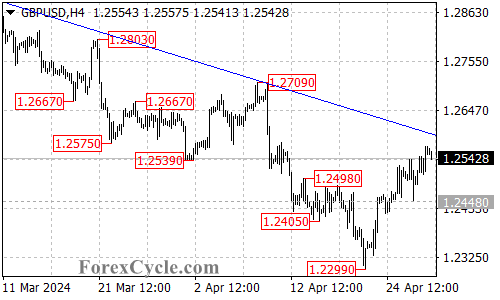GBPUSD has displayed renewed buying pressure, breaking above a key level. This analysis examines the technical situation and explores potential scenarios for the currency pair.

GBPUSD Stages Rally:
- Upside Move Gains Traction: GBPUSD has extended its rise, reaching a high of 1.2569. This move builds on the upward momentum from the initial low at 1.2299.
Uptrend or Correction? Falling Trend Line in Focus:
- Falling Trend Line Resistance: A key factor to consider is the falling trend line on the 4-hour chart. A breakout above this trend line would be a significant development.
- Breakout Signals Trend Reversal: If GBPUSD can decisively break above the falling trend line resistance, it would indicate a potential completion of the downtrend from 1.2893. This breakout could mark a shift towards a new uptrend.
- Upside Targets: In a bullish breakout scenario, the next potential target zones to watch would be 1.2700 and 1.2780.
Downtrend Shadow Looms:
- Correction Scenario: However, as long as the falling trend line resistance holds, the recent rise from 1.2299 could still be interpreted as a correction within the longer-term downtrend.
- Downturn Risk: If the correction scenario holds true, then another decline towards 1.2300 after the rally could be possible.
Support Levels to Consider:
- 1.2500 Initial Support: The initial support level to monitor is at 1.2500.
- Layered Support Zones: Breaches below this level could bring the price back towards the 1.2448 support zone, followed by the 1.2400 area, and ultimately the crucial 1.2300 level. A break below 1.2300 would confirm a resumption of the downtrend.
Overall Sentiment:
The technical outlook for GBPUSD is uncertain in the short term. The recent rally suggests a potential uptrend, but confirmation depends on the price action around the falling trend line. A breakout above the trend line would signal a potential trend reversal, while a failure to break and a decline through the support levels could indicate a continuation of the correction or even a resumption of the downtrend. Close monitoring of these levels is crucial.

